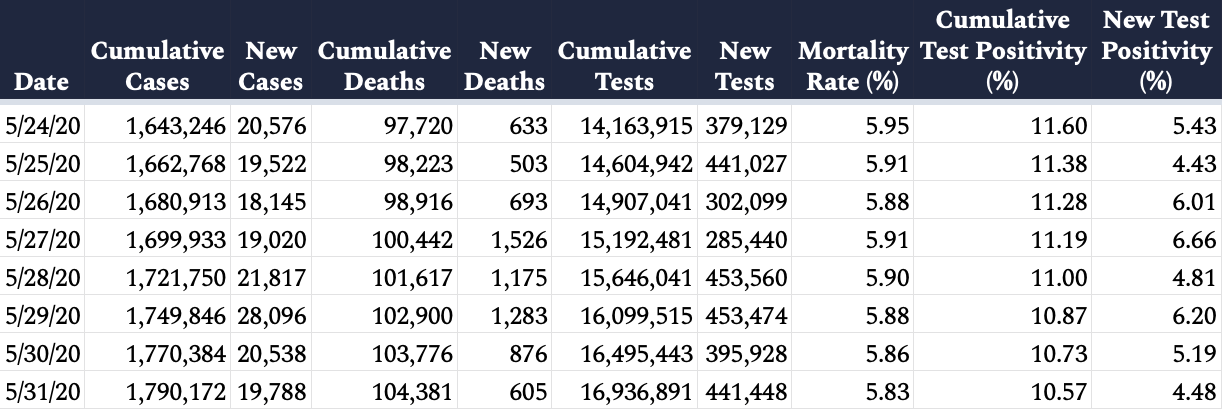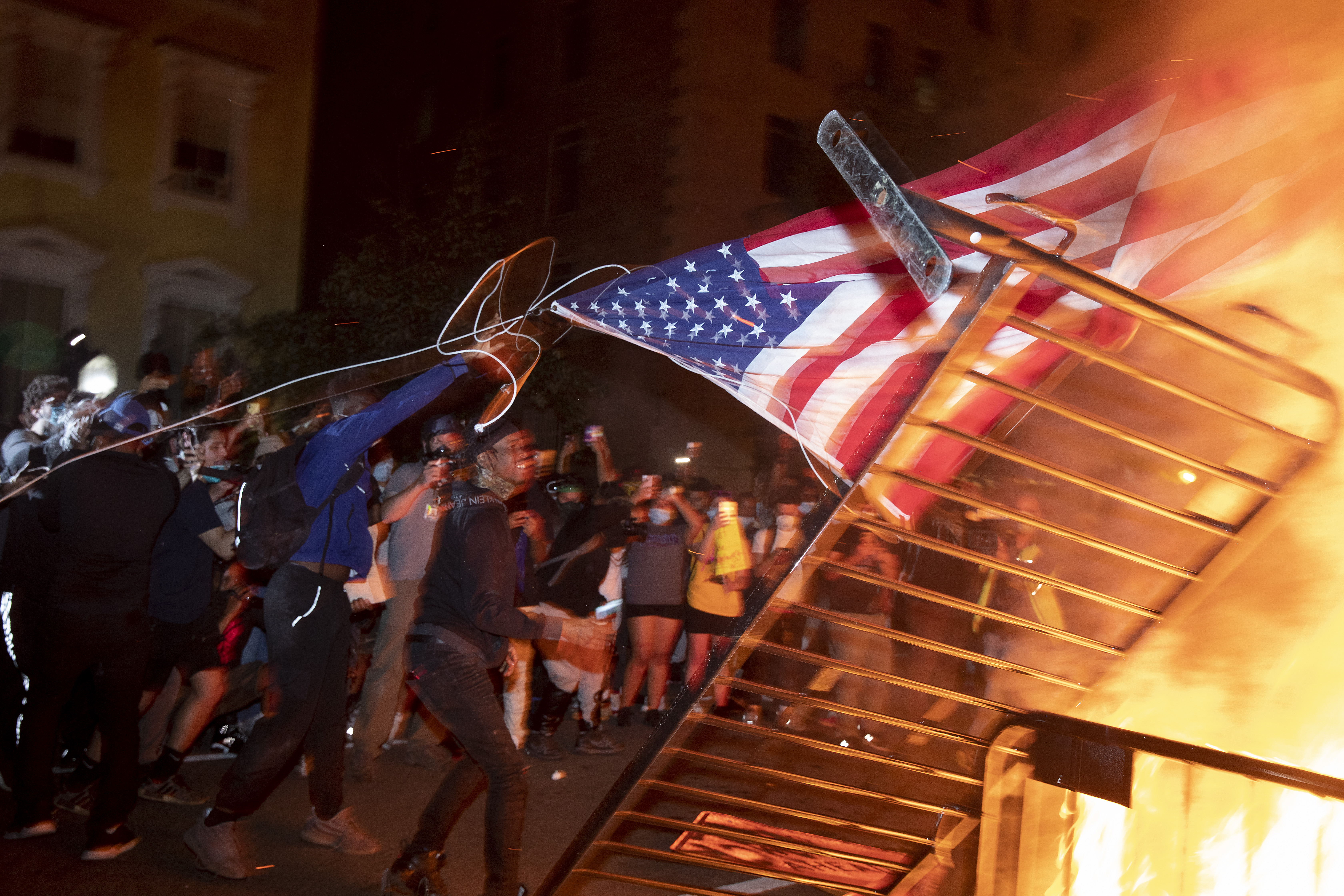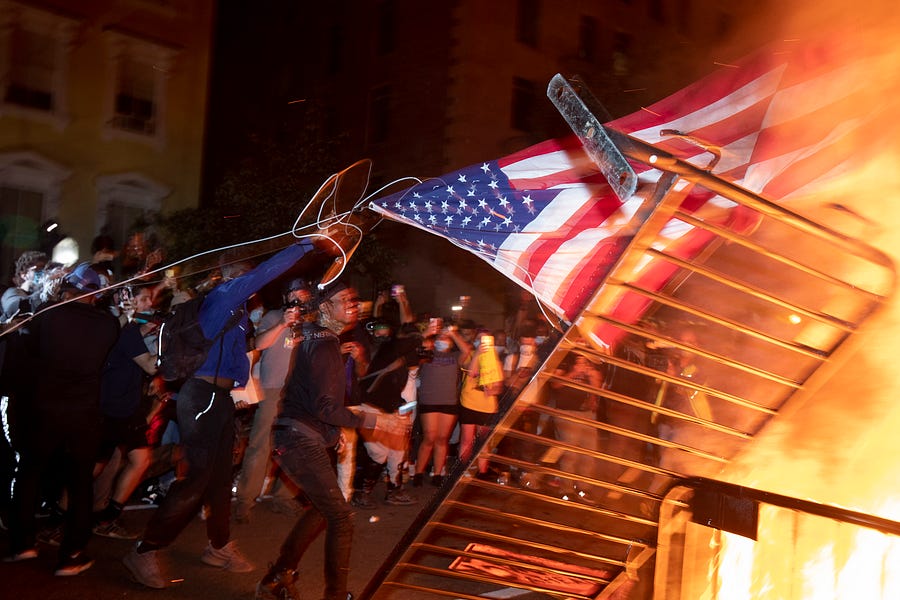Happy Monday. Another unconventional newsletter today after an unconventional weekend.
Quick Hits: Today’s Top Stories
-
As of Sunday night, 1,790,172 cases of COVID-19 have been reported in the United States (an increase of 19,788 from yesterday) and 104,381 deaths have been attributed to the virus (an increase of 605 from yesterday), according to the Johns Hopkins University COVID-19 Dashboard, leading to a mortality rate among confirmed cases of 5.8 percent (the true mortality rate is likely much lower, between 0.4 percent and 1.4 percent, but it’s impossible to determine precisely due to incomplete testing regimens). Of 16,936,891 coronavirus tests conducted in the United States (441,448 conducted since yesterday), 10.6 percent have come back positive.


-
Cobbling together “security footage, emergency services recording and cellphone video,” a team of investigative journalists at the Washington Post has assembled a video timeline of the minutes leading up to George Floyd’s death. Derek Chauvin, the officer pictured kneeling on George Floyd’s neck in the video that sparked protests across the country, has been arrested and charged with third-degree murder.
-
President Trump officially announced America’s withdrawal from the World Health Organization on Friday, saying that “China has complete control over” the international institution.
-
A growing body of evidence points to gaping racial disparities in the national coronavirus death rate, with black Americans being particularly hard hit. According to NPR, “African-American deaths from COVID-19 are nearly two times greater than would be expected based on their share of their population.”
-
The Trump administration declassified transcripts of phone calls between former National Security Adviser Michael Flynn and Russian diplomat Sergey Kislyak. The calls—monitored by American intelligence officials—show that Flynn did discuss sanctions with Kislyak, who was then the Russian ambassador to the United States.
-
On Saturday, NASA astronauts successfully launched a SpaceX Falcon 9 rocket into orbit. They safely docked the SpaceX Dragon capsule with the International Space Station the next day, completing the first successful supra-atmospheric launch ever operated by a private company.
-
President Trump said on Saturday he’s planning to postpone the G7 Summit—originally slated for the end of June—until September, adding that he’d like to invite the leaders of Russia, India, South Korea, and Australia to the conference as well to discuss the future of China.
A Weekend of Unrest

Chaos and confusion were the words of the day as protests sparked by George Floyd’s death continued to spread across the country over the weekend. In city after city, protesters and mayhem opportunists clashed with increasingly testy police forces, while social media filled up with supposed first-hand claims and contextless video snippets that made it difficult for those outside to discern what was really going on. More than 25 cities across the United States imposed curfews in an attempt to curb the destruction, while the National Guard was activated in 24 states and D.C.
In Minneapolis, the site of Floyd’s death and the epicenter of the protests, police who had retreated from violent protests last week on the mayor’s order—leaving a police precinct and dozens of nearby businesses to burn—grew more aggressive over the weekend, provoking complaints that police were acting too preemptively with tear gas and rubber bullets to disperse even law-abiding crowds but managing to head off the all-night riots and widespread property damage of days before. On Sunday, the most visible event was a protest march along a stretch of temporarily closed-off interstate—one that nearly ended in disaster when a tanker truck that had apparently declined to exit the highway barreled into the crowd at full speed, with many leaping out of the way just in time. The driver, who was subsequently dragged from his cab and attacked by protestors, suffered minor injuries and was arrested on probable cause for assault.
In Washington, D.C., the White House served as the focal point of the demonstrations. Protesters scuffled with Secret Service Friday night, and some attempted—unsuccessfully—to press though the metal barriers that surround the president’s residence. Property damage and looting was sporadic in nearby commercial areas, and a fire was started in the basement of a historic church near the White House. Fortunately, it was quickly extinguished.

Similar scenes played out across many cities over the weekend: massive, largely peaceful protests, smaller cohorts of rioters who nevertheless did plenty of damage, and police who frequently struggled to strike a balance between containing the latter and protecting the former. In Philadelphia, protesters hijacked a police car, burned others, and looted a number of businesses. In Atlanta, restaurants and jewelry stores were looted, and a mob attacked the headquarters of CNN. Nor was the damage constrained to big cities: Smaller locales from Santa Monica, California to Grand Rapids, Michigan suffered substantial looting too.
Many protesters were masked, but social distancing was near non-existent during these gatherings. “If you were out protesting last night, you probably need to go get a COVID test this week,” Atlanta Mayor Keisha Lance Bottoms said. “There is still a pandemic in America that’s killing black and brown people at higher numbers.”
Bottoms also announced that two officers had been fired for “excessive use of force” after a Saturday confrontation in which police stopped two college students who were leaving a protest in a car, smashed their window, slit their tires, tased them, yanked them from the vehicle and threw them to the ground. Their alleged crime? “Fleeing the scene”—by rolling forward about half a block after an officer they were talking to unexpectedly opened the driver door and attempted to pull the driver from the vehicle while it was still in drive.
Journalists by the dozens reported being struck by tear gas and rubber bullets at the scene of protests. In Minneapolis, one photographer was permanently blinded in one eye after being struck by a rubber bullet. And one widely shared video showed two New York City police SUVs attempting to force their way through a crowd blocking their path.
One complicating factor is worth noting here: At several of the protests, observers noted that a disproportionate number of agitators and vandals were young white men. Nancy French, who attended a protest in Nashville on Saturday (and is married to The Dispatch’s David French), reported that “every brick I saw thrown without exception was thrown by white people.” ProPublica reporter Jessica Huseman made a similar observation at Sunday’s protest in Austin, Texas.
Throughout the weekend, officials tried to determine whether outside agitators—including foreign actors—had tipped otherwise peaceful protests toward looting and violence. At a press conference on Friday alongside the mayors of Minneapolis and St. Paul, Minnesota Gov. Tim Walz said, “our best estimate right now that I heard is about 20 percent is what we think are Minnesotans, and about 80 percent are outside.” But by Saturday, the mayor of St. Paul acknowledged the information had been inaccurate and that, in fact, the majority of those arrested had come from the surrounding area.
On Sunday, President Trump announced on Twitter that “the United States of America will be designating ANTIFA as a Terrorist Organization.” This was followed by a statement from Attorney General Bill Barr arguing “the voices of peaceful and legitimate protests have been hijacked by violent radical elements” and that “the violence instigated and carried out by Antifa and other similar groups in connection with the rioting is domestic terrorism and will be treated accordingly.” Federal law defines the term “domestic terrorism,” but there is no federal crime or process for designating domestic terrorist organizations.
False information spread like wildfire on social media. In one such incident, a video of a man being beaten in Dallas was watched by millions of people alongside tweets which often claimed he had been killed or critically injured defending his business. The Dallas police department confirmed Saturday night, however, that the man was in stable condition following the incident and was not the owner of a business. A DPD spokesperson said the man arrived in the area “carrying a machete to allegedly protect his neighborhood from protesters. The victim confronted protesters while holding the machete and was subsequently assaulted.”
“Besides the aftermath of 9/11,” reporter Jonathan Martin tweeted out on Saturday night, “hard to recall another period in the last half-century that so cried out for national leadership.”
President Trump spoke about the nationwide protests from the Kennedy Space Center on Saturday afternoon, calling Floyd’s death a “grave tragedy” and adding that he “understand[s] the pain that people are feeling.”
“But what we are now seeing on the streets of our cities has nothing to do with justice or with peace,” he said. “The memory of George Floyd is being dishonored by rioters, looters, and anarchists. The violence and vandalism is being led by Antifa and other radical left-wing groups who are terrorizing the innocent, destroying jobs, hurting businesses, and burning down buildings.”
Aside from this trip to watch the SpaceX launch, Trump spent the rest of the weekend at the White House, at times whisked to the Presidential Emergency Operations Center (underground White House bunker). Despite reported calls from campaign advisers to make a nationally televised address to the nation, the president opted instead for his communication medium of choice. And off-teleprompter, the president struck a much different tone.
If protesters at the White House had breached the fence, he tweeted, “they would have been greeted with the most vicious dogs, and most ominous weapons, I have ever seen.” Trump claimed that Secret Service agents were hoping for encounters with agitators, relaying an alleged quote from an unknown Secret Service source: “We put the young ones on the front line, sir, they love it, and good practice.”
Elected officials—from Mitt Romney to Alexandria Ocasio-Cortez to Tim Scott to Ilhan Omar—also widely condemned the violence. House Democratic Whip Jim Clyburn encouraged the protesters to “harness the energy out there today & target that energy to make it a force on Election Day.”
Joe Biden, President Trump’s presumptive rival on Election Day, put out a statement in the wee hours of Sunday morning calling the protests “utterly American,” but adding that “needless destruction” is not. “We are a nation in pain,” he said, “but we must not allow this pain to destroy us. We are a nation enraged, but we cannot allow our rage to consume us. We are a nation exhausted, but we will not allow our exhaustion to defeat us.” Biden ventured outside his home on Sunday for just the second time since the pandemic began in earnest, visiting the site of Saturday night’s protests in Wilmington, Delaware.
Worth Your Time (Warning: Some Explicit Language)
-
Atlanta Mayor Keisha Lance Bottoms addresses rioters and looters.
-
Protesters organizing to stop the looting of a Target in Brooklyn.
-
Genesee County Sheriff Chris Swanson marching with protesters in Flint, Michigan.
-
Hundreds of volunteers in Minneapolis working to clean up the previous night’s devastation.
Toeing the Company Line
-
Jonah’s Friday G-File is a must-read. Picking up on the thesis of Julien Benda’s Treason of the Intellectuals, Jonah writes that the various “-isms” that seem to have taken hold of our politics—nationalism, socialism, populism and so on—have corrupted the way that our elite think about their role in our society. Our leaders increasingly see their job as catering to the desires of a particular group of people rather than championing a higher moral or philosophical ideal. And to make matters worse, the competing “isms” often represent entirely different groups of people, leading to what Jonah describes as “competing audiences that think they’re movements, and entertainers all too eager to tell them they’re right.”
-
Check out this latest special edition of The Dispatch Podcast, in which The Atlantic staff writer McKay Coppins joins Sarah and Steve for a fascinating discussion of the unrest throughout the country, disinformation, the increasingly partisan state of our media ecosystem and how smart, substantive news can survive.
-
In the chaos, pain and angry divisions of our current moment, it’s exceedingly difficult not to look at every issue through a tribal lens. In the Sunday French Press, David writes on the importance of maintaining our nation’s “center of moral and cultural gravity.” Isn’t it possible to simultaneously mourn the unjust killing of George Floyd and oppose the looting of small businesses? Must every tragedy that befalls our country be understood in partisan terms? We can’t continue like this. David writes: “The center has to hold. It’s time for the best of us to regain our conviction, to withstand the passionate intensity of our nation’s worst voices.”
Let Us Know
What can everyday Americans do to help repair our broken country?
Reporting by Declan Garvey (@declanpgarvey), Andrew Egger (@EggerDC), Sarah Isgur (@whignewtons), Alec Dent (@Alec_Dent), Nate Hochman (@njhochman), and Steve Hayes (@stephenfhayes).
Photographs of protests in Washington, D.C., by Tasos Katopodis/Getty Images.







Please note that we at The Dispatch hold ourselves, our work, and our commenters to a higher standard than other places on the internet. We welcome comments that foster genuine debate or discussion—including comments critical of us or our work—but responses that include ad hominem attacks on fellow Dispatch members or are intended to stoke fear and anger may be moderated.
With your membership, you only have the ability to comment on The Morning Dispatch articles. Consider upgrading to join the conversation everywhere.